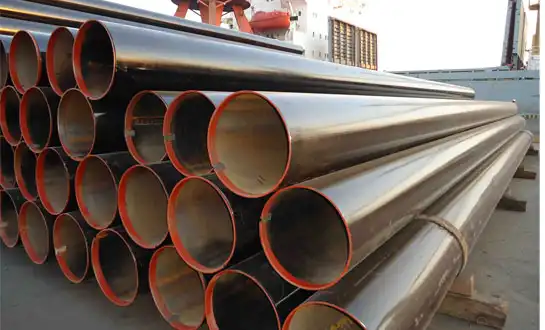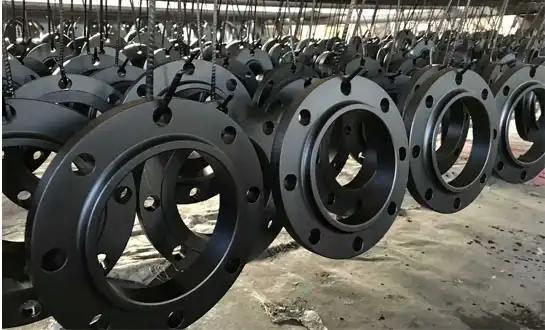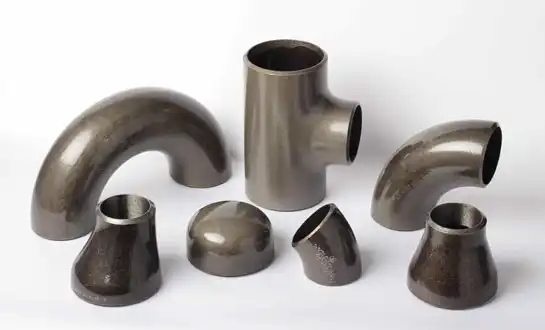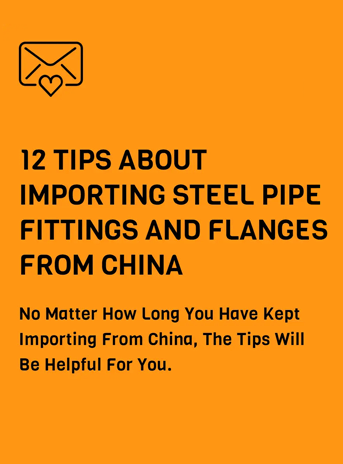Comparing Carbon Steel and Stainless Steel Pipe Fittings
When industrial projects need dependable piping systems, choosing between carbon steel and stainless steel pipe fittings is a very important choice that will affect performance, cost, and how long the fittings last. Both materials are popular in the market for various reasons, and each has its own pros and cons based on the climate, the amount of pressure needed, and the amount of corrosion exposure. Engineers, contractors, and procurement experts may make better decisions that match the needs of the project if they know the main distinctions between these steel pipe fittings. For normal use, carbon steel is strong and cost-effective. For more demanding situations, stainless steel is better at resisting corrosion. The products are rated on price, what they're made of, how well they work, and what they can be used for. This will help you pick the best thing.
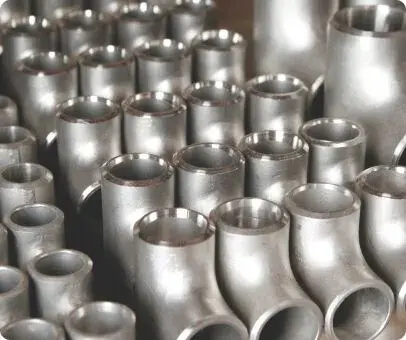
Material Composition and Manufacturing Differences
Chemical Structure and Alloy Content
Carbon steel pipe fittings contain primarily iron and carbon, with carbon content typically ranging from 0.05% to 2.0%, alongside trace amounts of manganese, silicon, and other elements. Because of their simple design, they are easy to make and don't cost much. You can use them in many places because they are strong. The material's properties vary based on carbon percentage—low carbon steel offers better weldability, medium carbon provides balanced strength, and high carbon delivers maximum hardness. Manufacturing processes for these steel pipe fittings include hot forming, cold forming, and machining techniques that shape raw materials into elbows, tees, reducers, and flanges. Stainless steel pipe fittings, conversely, incorporate chromium (minimum 10.5%) along with nickel, molybdenum, and other alloying elements that create a protective oxide layer on the surface. It changes a lot when it comes to water and chemicals because this material is high in chromium. It makes the material naturally immune to rust, which is something that carbon steel can't do on its own.
Production Methods and Quality Standards
The manufacturing approach for steel pipe fittings differs significantly between carbon and stainless varieties, influencing final product characteristics and pricing structures. Carbon steel fittings undergo processes like seamless rolling, welding from plate, or forging under high pressure, with subsequent heat treatment to achieve desired mechanical properties. To make sure that ASTM, ASME, and DIN requirements are met, quality control techniques include dimensional inspection, hydrostatic testing, and non-destructive examination. Stainless steel pipe fittings require more sophisticated production techniques due to harder material properties and specific alloying requirements. Manufacturers must control temperature precisely during forming operations to prevent chromium carbide precipitation, which can compromise corrosion resistance. When it comes to stainless steel goods, surface finishing is very important. Depending on the needs of the application, there are several choices, from mill finish to electropolished surfaces. Both material types benefit from certifications like ISO 9001:2015, GOST-R, and SGS validation, which verify manufacturing consistency and material traceability throughout production cycles.
Cost Implications and Market Availability
Economic considerations significantly influence material selection when specifying steel pipe fittings for industrial projects and infrastructure development. Carbon steel fittings typically cost 30-60% less than stainless equivalents in similar sizes and pressure ratings, making them attractive for budget-conscious projects where corrosion exposure remains minimal. Because so many vendors provide carbon steel, prices are comparable and standard designs may be delivered in less time. Carbon steel is cheaper because it uses less expensive raw materials, has simpler production methods, and has established supply channels. Stainless steel pipe fittings command premium pricing due to expensive alloying elements, complex production requirements, and specialized handling throughout manufacturing. But lifespan cost analysis frequently shows that stainless steel is a superior value in corrosive conditions since it doesn't need repair, replacement, or system downtime when carbon steel parts deteriorate. Market availability varies by grade—common stainless types like 304 and 316 remain readily accessible, while specialized alloys may require extended procurement timelines.
Performance Characteristics and Environmental Resistance
Corrosion Resistance and Longevity
Corrosion behavior represents the most significant performance difference between carbon steel and stainless steel pipe fittings in practical applications. When carbon steel comes into contact with water, it rusts quickly. To make it last longer, it has to be protected by galvanization, painting, or cathodic protection. In atmospheric conditions, unprotected carbon steel fittings may develop significant rust within months, compromising structural integrity and contaminating fluid systems. Even with coatings, carbon steel remains vulnerable at welded joints, threaded connections, and areas where protective layers become damaged during installation or operation. These steel pipe fittings perform adequately in dry environments or when properly maintained, but demand ongoing inspection and maintenance investments. Stainless steel pipe fittings naturally resist oxidation through their chromium oxide surface layer, which self-repairs when scratched or abraded in oxygen-rich environments. Grade 316 stainless steel, containing molybdenum, provides exceptional resistance to chlorides and acidic conditions, making it ideal for marine applications, chemical processing, and food production facilities where carbon steel would fail prematurely.
Mechanical Strength and Temperature Performance
Structural capabilities and thermal stability influence material selection for steel pipe fittings across diverse operating conditions and pressure requirements. Carbon steel has great tensile strength, usually between 400 and 550 MPa depending on the grade. Moving oil and gas, setting up lines, and running steam systems are all jobs that need to be done quickly and with a lot of force. The material keeps its mechanical properties at a lot of different temperatures, from very cold (cryogenic) conditions to close to 450°C. However, long-term exposure to temperatures over 400°C may produce graphitization, which makes the material less ductile. Carbon steel's higher thermal conductivity compared to stainless steel affects insulation requirements and heat loss calculations in thermal systems. Stainless steel pipe fittings offer comparable or superior strength depending on grade and condition, with austenitic types providing excellent low-temperature toughness without becoming brittle. However, stainless steel expands more during heating, requiring consideration in system design to accommodate thermal movement. Both materials can handle different pressure classes and schedule ratings. What you choose will rely on the purpose, your safety worries, and the rules that guide how pipe systems are built.
Chemical Compatibility and Industry Applications
Application environment determines which steel pipe fittings provide optimal performance, safety, and operational efficiency across industrial sectors. Carbon steel suits applications involving neutral pH fluids, petroleum products, natural gas, compressed air, and municipal water systems where corrosion rates remain manageable through proper treatment and maintenance protocols. Industries like construction, HVAC systems, fire protection networks, and general manufacturing rely heavily on carbon steel fittings for economic reasons while accepting periodic maintenance requirements. These fittings work best in high-pressure steam systems, structural applications, and circumstances where magnetic qualities are useful. Stainless steel pipe fittings become essential when handling corrosive chemicals, acidic or alkaline solutions, saltwater, pharmaceuticals, food products, and ultrapure water systems. Chemical processing plants, offshore platforms, beverage production facilities, semiconductor manufacturing, and medical equipment installations specify stainless steel to maintain product purity, prevent contamination, and ensure hygienic conditions that carbon steel cannot deliver despite protective coatings.
Selection Criteria and Decision Framework
Environmental Factors and Operating Conditions
Project-specific conditions should drive material selection for steel pipe fittings to optimize performance and minimize lifecycle costs. Evaluate exposure to moisture, humidity levels, chemical concentrations, temperature fluctuations, and potential for galvanic corrosion when dissimilar metals contact each other in electrolyte presence. Indoor controlled environments with minimal corrosive potential favor carbon steel's economic advantages, while outdoor installations, coastal locations, and corrosive atmospheres justify stainless steel's premium pricing. Consider whether systems require periodic drainage and drying or operate continuously filled with process fluids. Assess whether protective coatings on carbon steel fittings can be maintained effectively throughout expected service life or if access limitations make stainless steel's inherent protection more practical. These steel pipe fittings must withstand not only normal operating conditions but also upset scenarios, cleaning procedures, and maintenance activities that might compromise protective systems on carbon steel components.
Regulatory Requirements and Industry Standards
Compliance obligations and quality certifications influence material specifications for steel pipe fittings in regulated industries and international trade. Certain applications mandate stainless steel for sanitary reasons, contamination prevention, or corrosion safety margins, regardless of cost considerations. Food processing facilities must meet FDA requirements, pharmaceutical plants follow cGMP standards, and potable water systems comply with NSF/ANSI 61 certifications that may restrict carbon steel usage. Export markets require documentation including material test reports, heat numbers, and third-party certifications like GOST-R and SGS validation confirming compliance with destination country standards. Pressure vessel codes, building regulations, fire protection standards, and environmental protection rules may specify minimum corrosion allowances, material grades, or testing requirements that affect material selection. Working with certified pipes and fittings manufacturers who understand these requirements ensures project specifications meet all applicable standards while maintaining schedule and budget parameters.
Lifecycle Analysis and Maintenance Planning
Total cost of ownership extends beyond initial purchase price when comparing steel pipe fittings for long-term installations and critical infrastructure. Carbon steel's lower acquisition cost must be balanced against inspection schedules, coating maintenance, replacement intervals, and downtime expenses when corrosion compromises system integrity. Find the present value of maintenance jobs that need to be done in the future, like entry fees, output delays, and cleaning up the surroundings if there are leaks. Stainless steel pipe fittings don't need much care since they don't corrode, which lowers the cost of ownership over time, even if they cost more up front. Consider expected system lifespan—projects with 10-15 year horizons may favor carbon steel, while 30-50 year infrastructure investments often justify stainless steel. Just think about how things will work, how simple they'll be to keep, and how you'll repair them. Now you know more about the best things, you can choose them. Partner with experienced suppliers who provide technical support, material selection guidance, and quality documentation that facilitates informed decisions aligned with project objectives and long-term performance expectations.
Conclusion
There are pros and cons to both carbon steel and stainless steel pipe fittings. The cost, how well they will work in the environment, and how long they will last should all be taken into account. For most uses, carbon steel is strong and cheap, whereas stainless steel is the best choice for harsh situations since it doesn't rust. Engineers can choose the right materials that will keep the system reliable and cost-effective for its entire operating life if they understand these basic distinctions.
FAQ
1. Which steel pipe fittings offer better value for high-pressure water systems?
Carbon steel fittings provide excellent value for municipal water distribution where treatment controls corrosion, while stainless steel suits untreated or corrosive water applications. Which one to choose depends on the type of chemicals in the water, the cleaning plans, and how long the system is expected to last. A good study will show which option is the best for the situation.
2. Can carbon steel and stainless steel pipe fittings be used together in the same system?
When electrolytes are present, mixing these components has to be done with caution because of the risk of galvanic corrosion. Dielectric unions, isolation flanges, or non-conductive gaskets should separate dissimilar metals to prevent accelerated corrosion at connection points, though using consistent materials throughout simplifies installation and maintenance.
3. How do temperature extremes affect steel pipe fittings performance?
Carbon steel maintains strength at elevated temperatures but may become brittle at cryogenic conditions without proper grade selection. Stainless steel performs excellently at temperature extremes, particularly austenitic grades that retain toughness at extremely low temperatures while resisting oxidation at high temperatures.
4. What maintenance differences exist between carbon and stainless steel pipe fittings?
Carbon steel requires regular inspection, coating maintenance, and corrosion monitoring, while stainless steel needs minimal attention beyond cleaning. Over time, the cost changes a lot because of the different prices for upkeep. This means that stainless steel can be used in hard-to-reach places, even though it cost more at first.
HEBEI RAYOUNG PIPELINE: Your Trusted Steel Pipe Fittings Manufacturers
At HEBEI RAYOUNG PIPELINE TECHNOLOGY CO., LTD., we deliver both carbon steel and stainless steel pipe fittings that meet the highest quality standards for your critical projects. Our comprehensive product range includes buttweld elbows, reducers, flanges, and complete piping solutions backed by ISO 9001:2015, GOST-R, and SGS certifications. No matter if you need cheap carbon steel for regular use or stainless steel that won't rust in harsh conditions, our staff can help you choose the right materials for the job. We service both local and international markets with consistent quality, affordable prices, and delivery dates that you can count on to keep your projects on track. Ready to discuss your steel pipe fittings requirements? Contact our specialists today at info@hb-steel.com to receive technical specifications, compliance documentation, and competitive quotations tailored to your specific application needs.
References
1. American Society of Mechanical Engineers. (2023). ASME B16.9: Factory-Made Wrought Buttwelding Fittings. New York: ASME Press.
2. Davis, J.R. (2024). Corrosion of Carbon and Alloy Steels in Industrial Applications. Materials Park: ASM International.
3. European Committee for Standardization. (2023). EN 10253: Butt-Welding Pipe Fittings - Part 2: Non-Alloy and Ferritic Alloy Steels with Specific Inspection Requirements. Brussels: CEN Publications.
4. International Organization for Standardization. (2024). ISO 9001:2015 Quality Management Systems - Requirements for Manufacturing Industries. Geneva: ISO Standards.
5. Khan, M.A. & Peterson, R.L. (2023). Material Selection for Piping Systems: Engineering Economics and Performance Analysis. London: Technical Publishing House.
6. Smith, W.F. & Hashemi, J. (2024). Foundations of Materials Science and Engineering: Steel Alloys and Industrial Applications. New York: McGraw-Hill Education.

Need a quote? Want to see samples? Just say hello. We’re friendly. We’re fast. And we’re ready when you are.
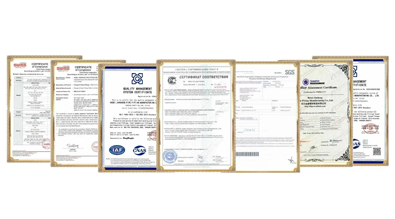
Welcome to RAYOUNG – Strong Pipes, Stronger Promise
